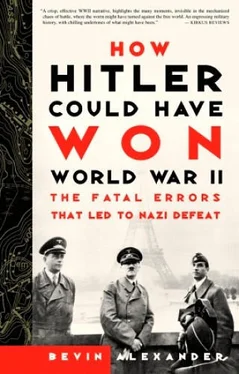p. 173: “invasion of northwest Africa.” Rommel, 192.
p. 175: “British mobile columns.” Ibid., 327, 395.
p. 176: “to keep their weapons.” Ibid., 358fn.
p. 176: “‘very great value,’ Rommel wrote.” Ibid., 396.
p. 177: “‘of nothing but jewelry and pictures.’” Das Deutsche Reich und der Zweite Weltkrieg, vol 6, 730–31; Rommel, 365–66.
p. 177: “secure from encirclement.” On January 6, 1943, the Italian command asked Rommel to transfer a division to Tunisia to assist in the defense there. Rommel, eager to get his Africa Corps out of Libya, selected the 21st Panzer Division, but required it to leave all its tanks, guns, and other equipment, saying the division could be reequipped in Tunisia. See Irving, 257–58.
p. 177: “‘be it to the west or the east.’” Das Deutsche Reich und der Zweite Weltkrieg, vol. 6, 732.
p. 179: “armies, not the air forces.” RAF nighttime attacks with incendiaries burned out large parts of the residential areas in the industrial Ruhr of western Germany, Cologne, and elsewhere. The greatest attacks were on Hamburg and Berlin. The Hamburg assault, which began July 24, 1943, created horrible firestorms that killed 32,000 people, made 900,000 homeless, and destroyed more than a quarter of a million houses and apartments. The Berlin assault began on November 19, 1943. Luftwaffe night fighters and antiaircraft defenses were readier for this threat, shooting down 492 aircraft and damaging 952 more so badly they had to be withdrawn from use. The 2,700 dead were far below the loss at Hamburg. Of 250,000 bombed-out Berliners, Joseph Goebbels evacuated many, and the remainder got emergency shelter. U.S. Army Air Force leaders believed B-17 bombers could deliver precision strikes on selected targets by flying in close formations or “combat boxes” that German fighters would be unable to penetrate. They were wrong. Losses were heavy. U.S. Army Air Force chief Henry H. (Hap) Arnold sent in Republic P-47 Thunderbolts to protect the bombers. The P-47s had only a short range (590 miles), however, and were unable to accompany the B-17s deep into Germany. The American theory had its first great tests on August 17, 1943, when German fighters shot down 36 of 183 B-17s on a raid against ball-bearing factories at Schweinfurt, and 24 of 146 bombers attacking the Messerschmitt works at Regensburg, both beyond the range of the P-47s. Production at both places continued. Eighth Air Force staged a second raid on Schweinfurt on October 14, 1943, using 291 B-17s. On the return flight, German fighters shot down 60 bombers, 17 crashed into the sea or in England, and 36 were damaged beyond repair—a single-day loss of 38 percent. Ball-bearing production was not interrupted. The cost was so great that doubts arose whether daytime bombing could be continued. However, Allied air commanders recognized the value of the North American P-51 Mustang fighter, which, with wing tanks, could reach a range of 2,200 miles, with a top speed (440 mph) comparable to the P-47, and higher than the top German piston-engined fighter, the Focke Wulf 190 (about 400 mph). P-51s did excellent service accompanying B-17s on deep raids into Germany. Even so, German industry was not paralyzed. Armaments minister Albert Speer transferred important industries to the east in 1942. Factories that had to remain were repaired quickly, large firms decentralized, and entire production branches transferred into caves, unused mines, and tunnels. Production actually increased. In 1943 Germany built 6,000 tanks (1942: 4,200) and 109,000 trucks and other vehicles (1942: 81,000); 36,500 cannons (1942: 23,500); 16,000 mortars (1942: 6,800); 4,180 antitank guns (1942: 1,300); and 4,400 88-millimeter antiaircraft guns (1942: 2,900); as well as 25,600 military aircraft (1942: 15,400). Most important, the destruction of German cities did not lead to a German collapse, as Sir Arthur T. Harris, chief of Bomber Command, had predicted. The German people began to identify their fate with that of the Nazi regime. See Dahms, 427–33; Crane, 93–119; Ronald Schaffer, Wings of Judgment: American Bombing in World War II.
p. 179: “to defeat the submarine menace.” Early in 1943 Hitler replaced Erich Raeder with Karl Dönitz, his U-boat expert, as navy chief. A big reason for the Allied shipping losses in 1942 was the disruption of Magic intercepts because of a change in the naval code of German Enigma radio signals early that year. At the beginning of 1943 cryptologists at Bletchley, England, broke the code, but soon the Germans put a new roller in the Enigma machines and another blackout ensued. German naval intelligence had cracked the Allied code, leading to the greatest convoy battle of the war, which commenced on March 16, 1943. The fast convoy HX 229 caught up with the slower convoy SC 122 in the Mid-Atlantic. The two convoys, with nearly a hundred ships, ran into 38 waiting U-boats, which sank 21 freighters totaling 141,000 tons, at the cost of one submarine. This disaster set off extraordinary efforts. At Bletchley, Magic cryptologists broke the new Enigma code, while naval leaders at last solved the problem of the “black pit”— the Atlantic gap 600 miles wide not covered by air patrols that stretched from Greenland to the Azores. Here Dönitz concentrated his submarines, where they attacked convoys as they left air cover and broke off when they regained it. A conference in Washington called by Admiral Ernest J. King ordered escort carriers to shield convoys through the gap and stepped up use of B-24 Liberators to cover the gap from land. These measures, plus vastly improved radar (a 10-centimeter wavelength apparatus that could not be picked up by U-boats), broke the hold of the subs. In May, the Allies sank 41 U-boats, 24 by aircraft. With these catastrophic losses, Dönitz ended convoy battles until scientists could come up with defenses, but no one developed any. Germany had lost the “supply war.” See Dahms, 421–24; Overy, 25–62; Liddell Hart, Second World War, 370–94.
Chapter 17: Kasserine and the End in Africa
p. 183: “half the strength of the division.” The Allies relied on Ultra intercepts, which seemed to point toward Fondouk, though observers on the spot noticed a German buildup at Faid. The concentration on Fondouk, Omar Bradley wrote, “came to be a near-fatal assumption.” See Bradley and Blair, 127; Bradley, 25.
p. 184: “withdrawal to the Western Dorsals.” Bradley, 25.
p. 184: “some of the supply dumps there.” General Lucian Truscott described Fredendall as “outspoken in his opinions and critical of superiors and subordinates alike…. He rarely left his command post … yet was impatient with the recommendations of subordinates more familiar with the terrain and other conditions than he was.” Omar Bradley wrote that Fredendall’s command post “was an embarrassment to every American soldier: a deep underground shelter dug or blasted by two hundred engineers in an inaccessible canyon far to the rear, near Tebessa. It gave the impression that, for all his bombast and bravado, Fredendall was lacking in personal courage.” See Bradley and Blair, 128.
p. 184: “‘uncertainty of command.’” Liddell Hart, Second World War, 405.
p. 185: “‘small private show of his own.’” Rommel, 401.
p. 185: “‘against the strong enemy reserves.’” Ibid., 402.
p. 187: “far lower tank losses.” Blumenson, Patton, 181.
p. 187: “barred his return to Africa.” Rommel, 418–19.
p. 188: “the defeat at Kasserine.” Alexander’s most damning indictment of Americans was in a letter to Alan Brooke: “They simply do not know their job as soldiers and this is the case from the highest to the lowest, from the general to the private soldier. Perhaps the weakest link of all is the junior leader who just does not lead, with the result that their men don’t really fight.” See Hastings, Overlord, 25.
Читать дальше


![Джонатан Димблби - Barbarossa - How Hitler Lost the War [calibre]](/books/385421/dzhonatan-dimblbi-barbarossa-how-hitler-lost-the-w-thumb.webp)









